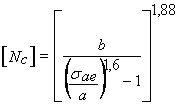
Service life analysis methods are applicable for steel industrial pipelines, as well as industrial furnace coils, the strength of which is analyzed according to GOST 32388-2013. Piping service life is determined as the minimum service life value of its elements and joints. Service life is the indicated time (in years, thousands of hours), at which piping operation must be stopped and its remaining strength must be analyzed. Input service life must not exceed 20 years.
In fatigue analysis for piping elements with moderate temperature, service life is calculated as:
 (1)
(1)
where NГ - full load cycles over 1 year of piping operation, [Nc] - allowable load cycles of a pipe element

where a= 80 MPa and b= 1200 - for elements from carbon and allowed non-austenitic steel; a=110 MPa and b=1000 - for elements from austenitic steel.
In fatigue analysis for high-temperature pipelines and coils service life is calculated as:
 at c > 1.0 (2)
at c > 1.0 (2)
 at c ≤
1.0
at c ≤
1.0
where


If stress analysis is not done, in the absence of corrosion wear, [T] value is calculated as:

Note: the factor 11.4 corresponds to 100 thousand hours. If element wall corrosion-erosion is present for medium-temperature pipelines, service life is calculated as:
 (3)
(3)
For high-temperature pipelines and coils with corrosion and static load
 (4)
(4)
where Vc- corrosion speed in mm/year, t, tR - nominal and design element wall thickness, С1 - wall mill allowance, m - indicator of degree of dependence of long-term tensile strength and time (in the absence of reference data, can be taken as 8).
For medium-temperature pipelines with material fatigue damage and corrosion-erosion wear, service life is calculated using formulas (1) and (3), and the lower value is used.
For high-temperature pipelines with material fatigue damage and corrosion-erosion wear, service life is calculated using formulas (2) and (4), and the lower value is used.
If design wall thickness is less than the minimum allowable for the selected pipe type for medium- and high-temperature pipelines, service life is calculated using formulas (3) and (4), where design thickness is replaced with minimum allowable, and the lower value is used.
When wear speed during initial piping operation is significantly reduced and sufficient experimental data are available, wall thickness mill through time can be expressed as:

In this case, when calculating service life with formulas (3) - (4), instead of С1, С1+Со should be used.